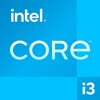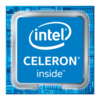Intel Core i3-1215U vs Intel Celeron N5095A vs Intel Pentium 8500
Intel Core i3-1215U
► remove from comparison
Der Intel Core i3-1215U ist eine Mid-Range Notebook-CPU auf Basis der neuen Alder-Lake-Architektur, die im Januar 2022 vorgestellt wurde. Die CPU basiert auf den Alder Lake-M Chip (für die U-Serie) und bietet 2 Performance Kerne (P-Kerne, Golden Cove Architektur) und 4 der 8 Effizienzkerne (E-Kerne, Gracemont Architektur). Die P-Kerne unterstützten Hyperthreading (daher gemeinsam 8 Threads) und takten von 1,2 bis 4,4 GHz. Die E-Kerne takten von 0,9 - 3,3 GHz und sollen eine vergleichbare Performance wie alte Skylake Kerne bieten (z.B. i7-6300HQ). Der Core i3 bietet keine vPro Features für Management.
Performance
Durch die 6 Kerne sollte die Multithread-Leistung deutlich oberhalb der alten 15 Watt 2-Kerner der Tiger Lake Serie liegen (wie z.B. dem i3-1115G4). Bei der Einzelkernperformance sollte der i3 dank der neuen Architektur auch ähnlich hoch getaktete Tiger Lake CPUs abhängen können.
Grafikeinheit
Wie auch der Vorgänger, integriert Intel in Alder Lake eine Intel Xe basierende Grafikeinheit. Beim 1215U sind 64 der 96 EUs aktiviert und takten mit bis zu 1,1 GHz.
Features
Wie auch Tiger Lake, hat auch Alder-Lake-P WiFi 6E und Thunderbolt 4 (4x) teilintegriert. Der integrierte Speicherkontroller unterstützt DDR5-4800, DDR4-3200, LPDDR5-5200 und LPDDR4x-4267. Der integrierte Gaussian and Neural Accelerator (GNA) ist nun in Version 3.0 verbaut. Die Media Engine Quick Sync 8 ist die selbe wie in Rocket Lake und unterstützt MPEG-2, AVC, VC-1 Decode, JPEG, VP8 Decode, VP9, HEVC und AV1 Decode. Der Chip unterstützt nur PCIe 4.0 (x8 for GPU und zwei x4 für SSDs).
Leistungsaufnahme
Der Intel Core i3-1215U ist mit 15 Watt (PL1) TDP und 55 Watt (PL2) max. Turbo Power angegeben. Gefertigt wird der Prozessor im modernen Intel 7 Prozess (10 nm).
Intel Celeron N5095A
► remove from comparison
The Celeron N5095A is an inexpensive quad-core SoC of the Jasper Lake product family designed for use in affordable SFF desktops and laptops. It features four Tremont CPU cores running at 2 GHz that Boost to up to 2.9 GHz with no thread-doubling Hyper-Threading technology in sight. A pretty basic iGPU is present as well.
The only difference between the N5095A and the N5095 is that the former comes with support for more proprietary Intel technologies such as the Smart Sound DSP, Wake on Voice and HD Audio.
Architecture and Features
Tremont brings many improvements over Goldmont Plus, the architecture that we know from the N5030 and myriads of other N-class CPUs. An up to 30% boost in single-thread performance is to be expected thanks to smarter prefetchers, branch prediction improvements and other refinements, according to Intel. These new chips are physically larger than their immediate predecessors as a result. Either way, this is still a "small" core rather than a "big" one according to ChipsAndCheese.
The Celeron has 1.5 MB of L2 and 4 MB of L3 cache and is compatible with DDR4-2933 and LPDDR4x-2933 memory or slower. Support for Intel CNVi Wi-Fi 6 modules is baked into the chip, as are 8 PCIe 3.0 lanes for NVMe SSD speeds up to 3.9 GB/s. USB 4 or Thunderbolt aren't supported however.
Please also note that the Celeron gets soldered to the motherboard (BGA1338 socket interface) for good and is thus not user-replaceable.
Performance
While we haven't tested a single system featuring the N5095A as of Sep 2024, we have done several reviews of computers/laptops powered by the N5095. CPU performance should be pretty much identical between the two. Therefore, we fully expect the chip to be about as fast as the Core i3-10110U, Core i3-1005G1, Celeron N5105 and also the Ryzen 3 3200U in multi-threaded workloads. Which is just enough for the most basic of tasks in late 2024.
Performance will get a significant hit if the power target is set to 10 W or 6 W instead of the Intel-recommended 15 W value.
Graphics
The DirectX 12.1-capable 16 EU UHD Graphics runs at up to 750 MHz and is in many respects similar to what Ice Lake CPUs come equipped with. This graphics adapter is capable of driving up to 3 SUHD displays simultaneously; HEVC, AVC, VP9, MPEG-2 and other popular video codecs can all be hardware-decoded. AV1 and VVC can't.
As far as gaming is concerned, it is reasonable to expect playable framerates in really old games (like Dota 2 Reborn) provided one sticks to lower resolutions such as HD 720p.
Power consumption
While most N-class chips have a 6 W long-term power target, the Celeron N5095A has a 15 W TDP to mimic much faster U-class Core processors. This isn't a great CPU for passively cooled designs.
The N5095A is built with the same 10 nm Intel process as Ice Lake-U processors for pretty unimpressive power efficiency, as of late 2024.
Intel Pentium 8500
► remove from comparison
Der Intel Pentium 8500 ist eine Notebook-CPU der Einstiegsklasse auf Basis der neuen Alder-Lake-Architektur, die im Januar 2022 vorgestellt wurde. Die CPU basiert auf den Alder Lake-M Chip (für die U-Serie mit 9W) und bietet einen Performance Kern (P-Kerne, Golden Cove Architektur) und 4 Effizienzkerne (E-Kerne, Gracemont Architektur). Der P-Kern unterstützten Hyperthreading (daher gemeinsam 6 Threads) und taktet von 1 bis 4,4 GHz. Die E-Kerne takten von 0,7 - 3,3 GHz und sollen eine vergleichbare Performance wie alte Skylake Kerne bieten (z.B. i7-6300HQ). Im Vergleich zum schnelleren Core i3-1210U, bietet der Pentium einen P-Kern weniger und ebenfalls keine vPro Funktionen.
Performance
Durch die 6 Kerne und die neue Architektur sollte die Leistung in allen Bereichen deutlich oberhalb der alten 7-Watt 4-Kerner der Comet-Lake-Y Serie liegen (wie z.B. dem i5-10310Y). Im Vergleich zum ähnlich benannten Pentium 8505U (15W) sollte jedoch der verringerte TDP deutlich limitieren.
Grafikeinheit
Wie auch der Vorgänger, integriert Intel in Alder Lake eine Intel Xe basierende Grafikeinheit. Beim Pentium sind 48 der 96 EUs aktiviert und takten mit bis zu 0,8 GHz.
Features
Wie auch Tiger Lake, hat auch Alder-Lake-P WiFi 6E und Thunderbolt 4 (4x) teilintegriert. Der integrierte Speicherkontroller unterstützt DDR5-4800, DDR4-3200, LPDDR5-5200 und LPDDR4x-4267. Der integrierte Gaussian and Neural Accelerator (GNA) ist nun in Version 3.0 verbaut. Die Media Engine Quick Sync 8 ist die selbe wie in Rocket Lake und unterstützt MPEG-2, AVC, VC-1 Decode, JPEG, VP8 Decode, VP9, HEVC und AV1 Decode. Der Chip unterstützt nur PCIe 4.0 (x8 for GPU und zwei x4 für SSDs).
Leistungsaufnahme
Der Pentium 8500 ist mit 9 Watt (PL1) TDP und 29 Watt (PL2) max. Turbo Power angegeben. Gefertigt wird der Prozessor im modernen Intel 7 Prozess (10 nm).
| Model | Intel Core i3-1215U | Intel Celeron N5095A | Intel Pentium 8500 | ||||||||||||||||||||||||||||||||||||||||||||||||||||||||||||||||||||||||||||||||||||||||||||||||||||||||||||||||||||||||||||||||||||||||||||||||
| Codename | Alder Lake-U | Jasper Lake | Alder Lake-U | ||||||||||||||||||||||||||||||||||||||||||||||||||||||||||||||||||||||||||||||||||||||||||||||||||||||||||||||||||||||||||||||||||||||||||||||||
| Series | Intel Alder Lake-M | Intel Jasper Lake | Intel Alder Lake-M | ||||||||||||||||||||||||||||||||||||||||||||||||||||||||||||||||||||||||||||||||||||||||||||||||||||||||||||||||||||||||||||||||||||||||||||||||
| Serie: Alder Lake-M Alder Lake-U |
|
|
| ||||||||||||||||||||||||||||||||||||||||||||||||||||||||||||||||||||||||||||||||||||||||||||||||||||||||||||||||||||||||||||||||||||||||||||||||
| Clock | 900 - 4400 MHz | 2000 - 2900 MHz | 700 - 4400 MHz | ||||||||||||||||||||||||||||||||||||||||||||||||||||||||||||||||||||||||||||||||||||||||||||||||||||||||||||||||||||||||||||||||||||||||||||||||
| L1 Cache | 544 KB | 464 KB | |||||||||||||||||||||||||||||||||||||||||||||||||||||||||||||||||||||||||||||||||||||||||||||||||||||||||||||||||||||||||||||||||||||||||||||||||
| L2 Cache | 5 MB | 1.5 MB | 3.5 MB | ||||||||||||||||||||||||||||||||||||||||||||||||||||||||||||||||||||||||||||||||||||||||||||||||||||||||||||||||||||||||||||||||||||||||||||||||
| L3 Cache | 10 MB | 4 MB | 8 MB | ||||||||||||||||||||||||||||||||||||||||||||||||||||||||||||||||||||||||||||||||||||||||||||||||||||||||||||||||||||||||||||||||||||||||||||||||
| Cores / Threads | 6 / 8 | 4 / 4 4 x 2.9 GHz Intel Tremont | 5 / 6 | ||||||||||||||||||||||||||||||||||||||||||||||||||||||||||||||||||||||||||||||||||||||||||||||||||||||||||||||||||||||||||||||||||||||||||||||||
| TDP | 15 Watt | 15 Watt | 9 Watt | ||||||||||||||||||||||||||||||||||||||||||||||||||||||||||||||||||||||||||||||||||||||||||||||||||||||||||||||||||||||||||||||||||||||||||||||||
| Technology | 10 nm | 10 nm | 10 nm | ||||||||||||||||||||||||||||||||||||||||||||||||||||||||||||||||||||||||||||||||||||||||||||||||||||||||||||||||||||||||||||||||||||||||||||||||
| max. Temp. | 100 °C | 100 °C | |||||||||||||||||||||||||||||||||||||||||||||||||||||||||||||||||||||||||||||||||||||||||||||||||||||||||||||||||||||||||||||||||||||||||||||||||
| Socket | BGA1744 | BGA1338 | BGA1744 | ||||||||||||||||||||||||||||||||||||||||||||||||||||||||||||||||||||||||||||||||||||||||||||||||||||||||||||||||||||||||||||||||||||||||||||||||
| Features | DDR4-3200/LPDDR4x-4266/DDR5-4800/LPDDR5-5200 RAM, PCIe 4, Thr. Dir., DL Boost, GNA, MMX, SSE, SSE2, SSE3, SSSE3, SSE4.1, SSE4.2, AVX, AVX2, BMI2, ABM, FMA, ADX, SMEP, SMAP, EIST, TM1, TM2, HT, Turbo, SST, AES-NI, RDRAND, RDSEED, SHA | DDR4-2933/LPDDR4x-2933 RAM, PCIe 3, GNA, MMX, SSE, SSE2, SSE3, SSSE3, SSE4.1, SSE4.2, VMX, SMEP, SMAP, EIST, TM1, TM2, Turbo, SST, AES-NI, RDRAND, RDSEED, SHA | LPDDR4x-4266/LPDDR5-5200 RAM, PCIe 4, Thr. Director, DL Boost, GNA, MMX, SSE, SSE2, SSE3, SSSE3, SSE4.1, SSE4.2, AES, AVX, AVX2, FMA3, SHA | ||||||||||||||||||||||||||||||||||||||||||||||||||||||||||||||||||||||||||||||||||||||||||||||||||||||||||||||||||||||||||||||||||||||||||||||||
| iGPU | Intel UHD Graphics 64EUs (Alder Lake 12th Gen) ( - 1100 MHz) | Intel UHD Graphics (Jasper Lake 16 EU) (450 - 750 MHz) | Intel UHD Graphics Xe G4 48EUs ( - 800 MHz) | ||||||||||||||||||||||||||||||||||||||||||||||||||||||||||||||||||||||||||||||||||||||||||||||||||||||||||||||||||||||||||||||||||||||||||||||||
| Architecture | x86 | x86 | x86 | ||||||||||||||||||||||||||||||||||||||||||||||||||||||||||||||||||||||||||||||||||||||||||||||||||||||||||||||||||||||||||||||||||||||||||||||||
| Announced | |||||||||||||||||||||||||||||||||||||||||||||||||||||||||||||||||||||||||||||||||||||||||||||||||||||||||||||||||||||||||||||||||||||||||||||||||||
| Manufacturer | ark.intel.com | ark.intel.com | ark.intel.com |
Benchmarks
Average Benchmarks Intel Core i3-1215U → 0% n=0
* Smaller numbers mean a higher performance
1 This benchmark is not used for the average calculation












